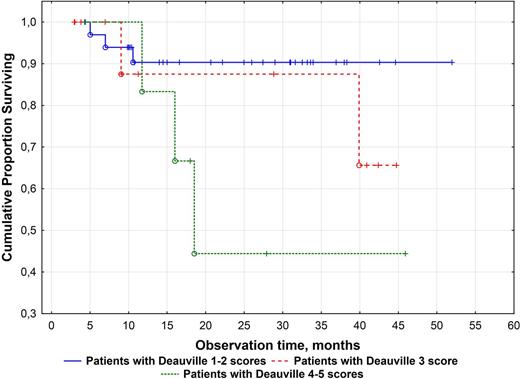Abstract
Introduction. PET-CT is the new standard for staging of patients with Hodgkin Lymphoma (HL). However, it is becoming obvious that the role of PET-CT in assessment of response is not limited to imaging at the end-of-treatment. In recent years the prognostic role of interim PET-CT and attempt to use PET response-adapted therapy has come under evaluation across a number of international studies with promising results. Here we report the results of a multicenter retrospective study of interim PET in HL.
Methods. 53 patients with HL with a stage I-II (64%), III-IV (36%) who were admitted between August 2012 and May 2017 to 10 Ukrainian hematological centers were included in this retrospective analysis. Metabolic PET-CT imaging was performed at participating PET centers according to routine protocols, compatible with EANM guidelines for FDG PET-CT imaging in malignant tumors. Interim PET (PET2) was performed at 15.5 ±3 days (range, 5-26) after 2d and 4th cycles of traetment in 75% and 25% cases, respectively. Patients were treated with ABVD or BEACOPP-14/esc based on risk group. The primary endpoint was event-free survival (EFS), defined as disease progression or death from HL.
Results. Median age of patients at diagnosis was 32 years (range 17-56), and 63% of patients were female. B symptoms were present in 42% (22/53), extranodal disease in 4% (2/53), and bulky disease (>10 cm in any dimension) in 25% (13/53) of pts. Median follow-up was 24 months from diagnosis. Interim PET-CT, performed after chemotherapy, was categorized as Deauville 1-2 in 34 patients (56%), Deauville 3 in 12 (32%), Deauville 4 in 5 (10%), and Deauville 5 in 2 (2%). The threshold of positivity was set for a residual uptake higher than the liver background (grade 4 and 5 of the scale).
13% (7/53) and 87% (46/53) patients in our cohort were PET2-positive (PET2+) and negative (PET2-), respectively (p<0.05). In total, disease progression was documented in 43% (3/7) of PET2+ patients and 11% (5/46) if PET2-negative patients (p<0.05). There was 1 death from refractory disease. 3-year EFS for patients with PET2+ vs PET2- was 45% vs 77%, respectively (p<0.05).
Also, we compared EFS in patients with PET2 according to the Deauville score subgroups: 1-2 vs 3 vs 4-5 scores. The 3-year EFS was significant difference: 91% for the Deauville 1-2 subgroup versus 86% for Deauville 3 versus 46% for Deauville 4-5, (p < 0.004).
Conclusion. Interim PET-CT is an important tool for clinicians in the diagnosis and management of patients with HL. The pronostic role and validity of the Deauville 5PS for interpretation of interim PET should be confirmed prospectively.
No relevant conflicts of interest to declare.
Author notes
Asterisk with author names denotes non-ASH members.


This feature is available to Subscribers Only
Sign In or Create an Account Close Modal